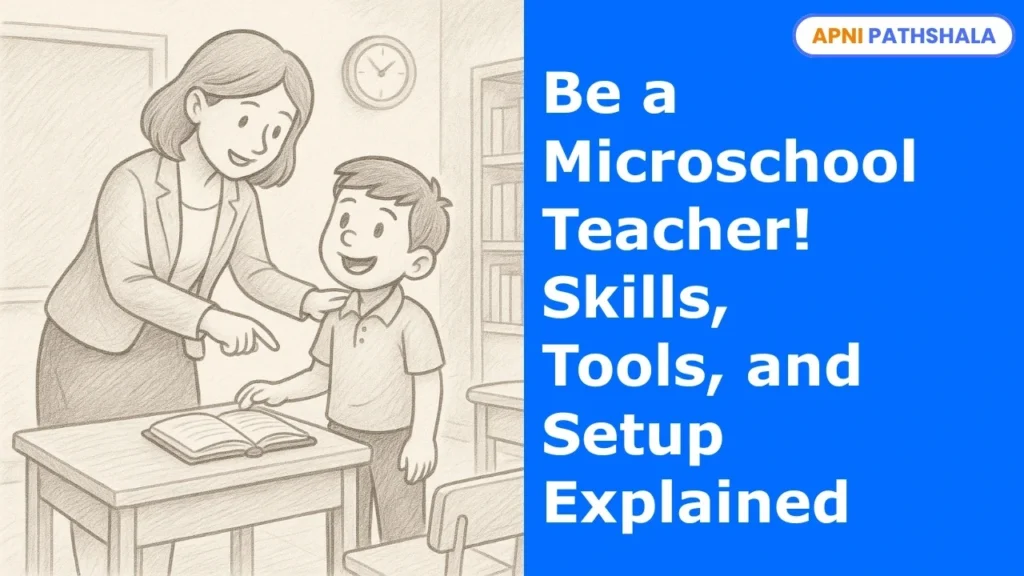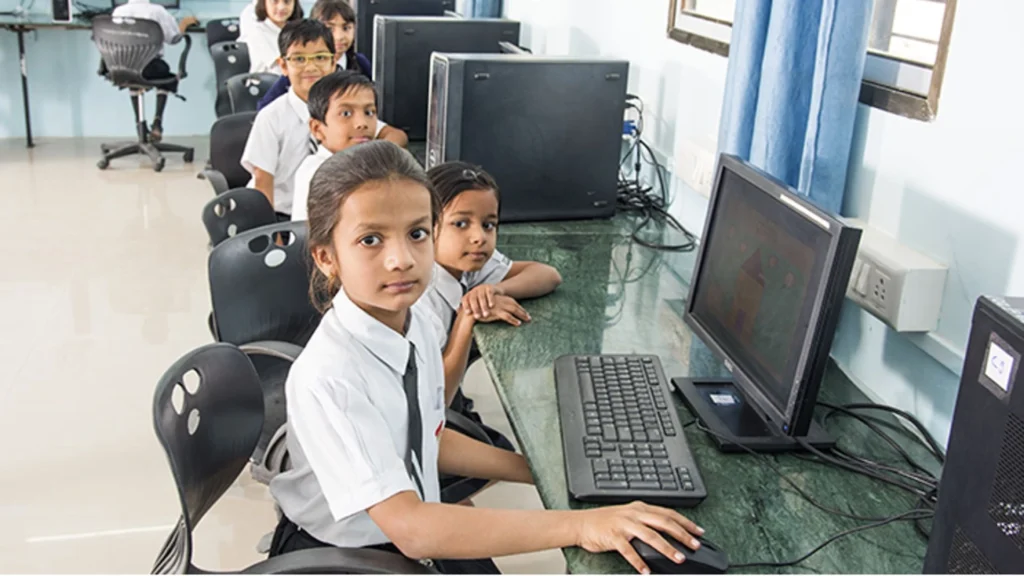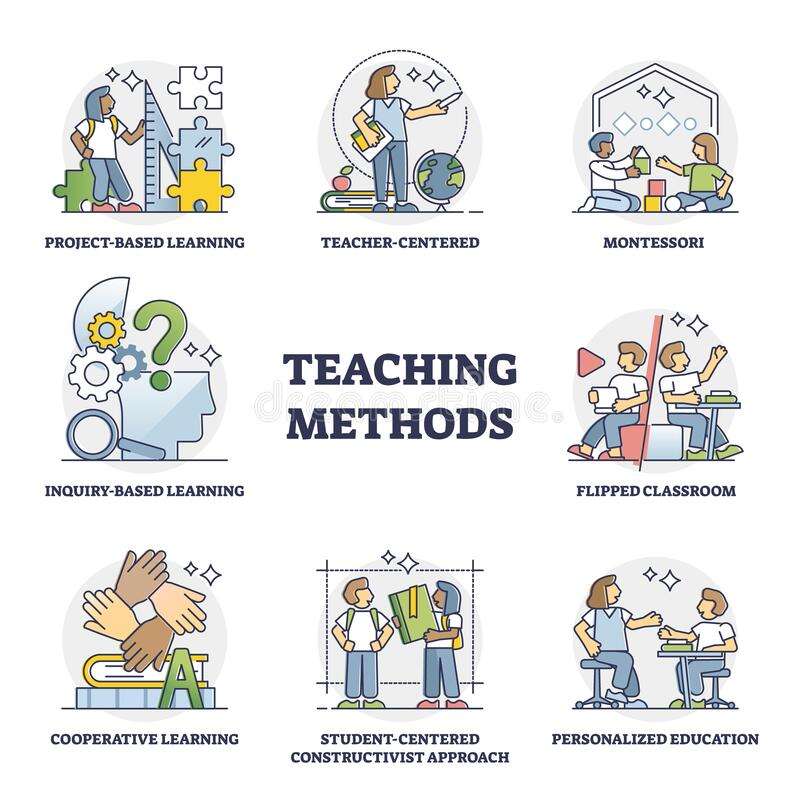Be a Microschool Teacher: Skills, Tools, and Setup Explained

The Best Way to Learn Is to Teach Do you want to be a teacher? Then try becoming a microschool teacher. But before we talk about how, let’s understand why. Why Microschools Matter More Than Ever Microschools are growing rapidly around the world. In fact, thousands of families now choose microschools as a preferred learning option because they offer something most traditional schools don’t: personal attention, community learning, and flexibility. Imagine a classroom where the teacher knows your name, tracks your progress, and actually adapts the learning to suit you. Now compare that to the overcrowded classrooms we grew up in, where students often got lost in the crowd. With private school fees rising across India and government schools lacking infrastructure, parents are urgently seeking better educational options. This is why microschools are becoming the preferred choice for both parents and students. So, what is a microschool, and how can you become a teacher in one? Why Become a Microschool Teacher? Microschools are small, community-led classrooms with 5–15 students that focus on personalized learning, curiosity, and project-based exploration. These schools blend traditional teaching with digital tools and peer learning, making education feel more human, flexible, and local. We all wanted a teacher who truly understood us.Many of us didn’t find one.But now, we can become that teacher. Here’s why it works: What a Microschool Teacher Should Know 1. Know Your Strengths Start by asking yourself a few simple questions: Choose a niche that fits you. It could be: 2. Skills Needed to Be a Good Microschool Teacher You don’t need a teaching background certificate.Focus on: Tools You Can Use: 👉 Explore: Top AI Tools for Parents 👉 Read: Mastering Self-Learning 2. Find a Microschool Near You Before starting, check if there’s already a microschool in your area.You can: If you can’t find one nearby, that’s your opportunity to open your own Microschool. 3. Build a Learning Plan Once you identify your strengths, skills, and preferred location, tailor your teaching plan accordingly. Pay attention to the topics you discuss with the most passion, or consider teaching a friend or child to see where you feel most confident. This is your starting point. Here’s how: A flexible plan is better than a perfect one. Just start, adjust as you go, and keep learning together. 4. How to Start Your Own Microschool 💡 ApniPathshala supports educators by offering computers and guidance for setting up digital microschools. 👉 Learn more about each step in our blog: How to Open a POD Common Questions Do I need a certificate to teach in a microschool?No, you just need skills and the ability to explain things clearly. What can I teach?Anything from basic academics to digital skills, coding, or even communication, whatever you’re confident in. Can I start part-time?Yes. Many microschool teachers begin with evening or weekend batches. How do I earn?You can charge a small fee or run it on donations, based on your model. Where should I set up my microschool?Any quiet, clean space near your home works well. Just ensure you have all the necessary setup resources: good lighting, comfortable seating, Wi-Fi, etc. Final Thoughts Microschools are more than just a response to rising school fees; they are a return to meaningful, focused, and community-based learning. As a microschool teacher, you don’t just teach a subject; you mentor, guide, and shape lives in a way traditional classrooms often can’t. If you’ve ever dreamed of becoming the kind of teacher who knows each student by name, understands their challenges, and helps them grow, this is your chance. You don’t need to wait for permission. All you need is a space, a plan, and the passion to make a difference. Comment down which type of teacher you really want to be.👉 Want to see how others started? Read real success stories from our PODs across India. 👉 Curious how to begin? Visit apnipathshala.org to learn how to start your own POD, explore tools, or get support.
7 Popular Alternative Education Models | Benefits & Insights

Education is evolving. Children are no more interested in sitting 8-9 hours in a four walled room and studying. With the arrival of technology and access to smart devices (thanks to covid), traditional classrooms have become increasingly less effective for many students. So, the next best option- alternative education models are gaining popularity. These methods allow children to explore their interests, learn at their own pace, and develop skills that prepare them for a changing world. As the name suggests, I’m sure you must have a fair idea of what alternative education is. But, what about the different models? In this blog, we will explore some of the most popular types of alternative education today, explaining their principles and why they might be the right fit for your child. 1. Montessori Education First we have Montessori education. Developed by Dr. Maria Montessori in the early 1900s, it’s one of the most well-known and established forms of alternative education. This approach prioritizes a child’s natural curiosity and promotes self-directed learning. In a Montessori classroom, students are free to choose their activities, which encourages independence, problem-solving, and creativity. What are the benefits of Montessori Education? Montessori schools are present worldwide, from preschools to high schools, and are a popular choice for parents who value flexibility and a personalized education. 2. Waldorf Education Founded by Rudolf Steiner in 1919, Waldorf education aims to educate the whole child—intellectually, emotionally, and physically. Waldorf schools focus on integrating academic subjects with creative arts like music and painting. The goal is to nurture the development of each student, helping them grow into well-rounded individuals. What are the benefits of Waldorf Education? This approach is ideal for families who believe in developing emotional intelligence, creativity, and a deeper connection with nature and the world around them. 3. Reggio Emilia Approach The Reggio Emilia approach originated in Italy after World War II and is centered on the idea that children are competent learners capable of building their own knowledge. In this model, children are encouraged to explore their interests through projects and inquiry-based learning This makes them active participants in their educational journey. What are the benefits of Reggio Emilia Approach? Reggio Emilia has gained international stature, with schools adopting its principles around the world, from the United States to Australia. 4. Homeschooling Homeschooling is one of the most flexible forms of alternative education. Talking about statistics, the number of homeschooled students in India ranges between 500 000 and 2.7 million. And, that is huge! Parents take on the responsibility of teaching their children at home, allowing them to design the curriculum to suit the child’s individual learning style, interests, and pace. This model offers unparalleled freedom and the ability to adapt the educational experience to fit the child’s needs. What are the benefits of Homeschooling? As homeschooling grows in popularity, especially after the global pandemic, it has become an accessible option for many families who want to take a more hands-on approach to education. 5. Online Learning Next we have the most popular form of alternative education- Online Learning. It might be a scary phrase for some of the parents out there, but it is what it is! The rise of technology has made online learning an increasingly viable option for students worldwide. Online education offers the flexibility of learning from home or anywhere with an internet connection. It includes both formal online schools and informal learning platforms offering specific courses or subjects. What are the benefits of Online Learning? Online learning continues to grow, providing an invaluable option for students who need more flexibility or live in remote areas without easy access to traditional schools. 6. Microschools Microschools are small, independent schools that provide personalized education in a community setting. These schools are typically made up of fewer than 150 students and focus on fostering strong relationships between teachers and students. The approach is highly adaptable, allowing for small group instruction and a focus on individual learning needs. What are the benefits of Microschools? Not talking about ApniPathshala while discussing microschools won’t be a right thing to do. This organisation offers a unique approach to education, closely aligned with the principles of microschools. ApniPathshala empowers both parents and students with the flexibility to create a perfect and personalized educational experience. Whether you’re looking for homeschooling options, online resources, or community-driven educational tools, ApniPathshala ensures that every child has the support they need to succeed in their educational journey. If you want to be a part of the journey of providing quality education to kids in every corner, contact ApniPathshala straight away! 7. Project-Based Learning Last but not the least, we have Project-based learning (PBL). It is an educational approach where students work on a project over an extended period, learning about a subject in-depth while solving real-world problems. This practical, student-driven approach encourages critical thinking, collaboration, and creativity. What are the benefits of Project- Based Learning? As educational systems evolve, alternative learning models provide a variety of options for parents and students seeking a more personalized and holistic approach to learning. From Montessori’s self-directed approach to online learning, these alternative educational models cater to diverse learning styles. This overall helps students work and grow in environments that suit their individual needs. Whether you’re looking for an arts-based approach, flexible learning, or learning in small groups, alternative education provides a range of options to help children reach their full potential. As these models continue to grow in popularity, the future of education looks brighter, more inclusive, and adaptable than ever before. If you wanna be a part of a journey that constantly works for the betterment of kids- urban and rural, join hands with ApniPathshala. Let’s make a change together!
10 Best Learning Methods To Maximize Kids’ Growth

Community-based learning pods are revolutionizing education by offering a unique and dynamic learning environment. Unlike traditional schools, pods can tailor their approach to each student, fostering a love of learning and maximizing their potential. This blog explores ten powerful teaching methods that can be implemented in your learning pod: 1. Flipped Classrooms: Learning at Your Own Pace Forget the one-size-fits-all approach! Flipped classrooms empower students to learn foundational concepts at home using online resources. This frees up class time for in-depth discussions, problem-solving activities, and personalized support. 2. Game On! Engaging with Educational Games Learning doesn’t have to be a chore. Educational games tap into students’ natural love of play, using competition, rewards, and interactive elements to solidify concepts and boost engagement. 3. Putting Students in Charge: Student-Centered Learning Student-centered learning empowers students to take ownership of their education. By fostering exploration of personal interests and connecting them to broader subjects, this approach ignites curiosity and a deeper understanding. 4. Spark Curiosity: Inquiry-Based Learning Inquiry-based learning encourages critical thinking by posing open-ended questions and challenging students to find their own solutions. This approach fosters independent thought, research skills, and a love for discovery. 5. Learning by Doing: Project-Based Learning Project-based learning goes beyond textbooks. Students tackle real-world problems, developing critical thinking, collaboration, and interdisciplinary skills that will serve them throughout their lives. Problem-Based Learning: A Challenge to Conquer Similar to project-based learning, problem-based learning throws students headfirst into a challenge before any instruction begins. This sparks curiosity and encourages research as they find solutions on their own. 7. The Power of Discussion: Discussion-Based Learning Learning thrives on interaction. Discussion-based learning encourages collaboration and critical thinking as students explore topics from different perspectives. It hones communication skills and promotes independent learning. 8. Learning Through Play: Play-Based Learning for Young Minds Play isn’t just fun; it’s essential for young learners! Play-based learning allows students to develop social skills, explore their curiosity, and build a strong foundation for future academic success. 9. Service Learning: Making a Difference in the Community Service learning blends classroom learning with real-world volunteer work. By tackling community issues, students gain practical experience, develop empathy, and see how academic concepts can make a positive impact. 10. Social-Emotional Learning: Building Well-Rounded Individuals Social-emotional learning (SEL) equips students with the skills they need to navigate both academic and personal challenges. It focuses on self-awareness, emotional regulation, and relationship building, fostering well-rounded individuals prepared for future success. By incorporating these diverse teaching methods, community learning pods can create a dynamic and stimulating learning environment that caters to every student’s unique needs and learning styles. Let’s unleash the potential within each student and foster a lifelong love of learning! Frequently Asked Questions What is a flipped classroom? In a flipped classroom, students learn foundational concepts at home using online resources or other materials. Class time is then used for more in-depth discussions, problem-solving activities, and personalized support. What are the benefits of game-based learning? Educational games can make learning more engaging and interactive, helping students retain information better. They can also promote critical thinking, problem-solving, and healthy competition. How does student-centered learning work? Student-centered learning focuses on the interests and needs of each student. Teachers provide resources and guidance, but students have more autonomy over their learning journey, allowing them to explore topics that spark their curiosity. What is the difference between project-based and problem-based learning? Both methods involve students working on a real-world challenge. Project-based learning often starts with a clear goal or question, while problem-based learning throws students headfirst into a challenge before providing instruction. How can I find resources for these teaching methods? Many online resources and educational organizations offer support and guidance for implementing these teaching methods. Additionally, teacher communities and education conferences can be valuable sources of information. What are the challenges of implementing these methods? Some teaching methods may require additional planning and preparation from teachers. Additionally, creating a supportive and collaborative learning environment is crucial for success. Conclusion:Unleashing Potential and Igniting a Passion for Learning Community learning pods offer a unique opportunity to revolutionize education. By implementing these ten powerful teaching methods, you can create a dynamic and engaging learning environment that caters to each student’s individual needs and learning styles. From the personalized approach of flipped classrooms to the collaborative spirit of discussion-based learning, these methods foster a deeper understanding, critical thinking skills, and a love of learning that will stay with students throughout their lives.Remember, the ultimate goal is to empower students to take charge of their education, explore their passions, and develop the well-rounded skills they need to thrive in the real world. So, embrace the flexibility of community learning pods, unleash the potential within your students, and ignite a lifelong passion for learning together! Developed by Pranav Gorathe
